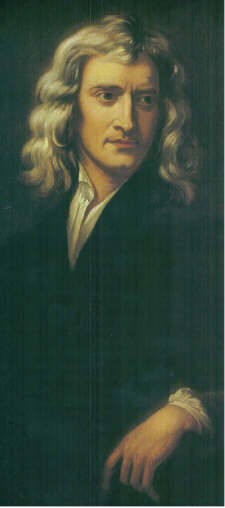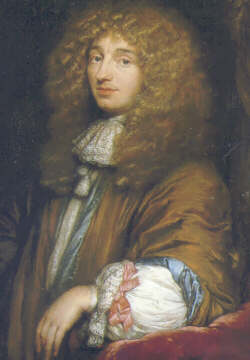 Department
of
Department
of
Science & Technology Studies
University College London
Nicholas Kollerstrom's
Newton's 1702 Lunar Theory
The Moon-Test of 1684
How far would the Moon fall 'if stopped?' This arresting
concept was the basis for the so-called 'Moon-test'. As the very first
computation to appear in Book III (of the First Edition), it had a key
significance, as linking together terrestrial and celestial mechancs. Newton
calculated that, in one minute, the Moon 'if stopped' would fall the same
distance as would an object on Earth in one second: a convenient 60:1 ratio,
a result of the lunar distance being sixty Earth-radii. The 'Moon-test'
was one of the most original things he ever did, as the notion of using
the 27.3-day sidereal lunar month to demonstrate gravitational force had
not hitherto ocurred to anyone.
The first record of it occurs in the autumn of 1684, when
the manuscript De Motu delivered to Halley described the general
idea:
'My calculations reveal
that the centripetal force by which our moon is held in her monthly motion
about the earth is to the force of gravity at the surface of the earth
very nearly (quamproxime) as the reciprocal of the square of the distance
from the centre of the earth' (Cohen 1980 p266).
The computation was then written up, using a value of 60
Earth-radii as the lunar distance, a one-body computation of uniform circular
motion around an immovable centre, which became Proposition IV of Book
III. A recent commentary by Dana Densmore describes this calculation as
"perhaps the most thrilling demonstration in the Principia," and
advised
"Pause to ponder the coincidence
-- or try to explain it! -- that gives the same number for the Moon's fall
in a minute from orbit and in a second at the surface." (Densmore, 1996
p298)
In the next century, in 1713, the computation became a two-body
problem, carried out to nine rather than five significant figures, though
actually less accurate (See Lunar Mass Error.).
If stopped, readers were informed, the Moon would fall 14.7706353
feet in one minute. (The first two digits are correct.)
These two versions appear in both Propositions 4 and 37,
using two different sets of numerical values, with little explanation given
for the discrepancy, being the only computation to appear twice in the
Principia.There was no use of acceleration, or even of velocity,
in this computation, despite innumerable popular accounts which have described
it as measuring the acceleration due to gravity (Kollerstrom, 1991). That
is how it would be done nowadays, but the text does not allude to such.
This calculation alluded four times to the Dutch natural
philosopher Christiaan Huygens -- partly for his estimation of freefall's
magnitude (the distance fallen in one second on the Earth's surface) as
he derived it from experiments with pendulum clocks. Despite this Huygens
later produced an account concerning his dismissal of Newton's gravity
theory!
 A
Durable Myth
A
Durable Myth
As everyone knows, claims were made that this computation
had been attempted in the 1660s, and not until the researches of Tom Whiteside
were historians able to escape from the ruinous clutches of this illusion.
Earlier writers had puzzled over a supposed delay of nearly twenty-years,
between the discovery of the law of gravity in or around the year 1666
and its first reported use in the years 1684-5. Let's quote from Whiteside's
bold declaration, as it has (I suggest) exerted a greater influence upon
Newton-studies in modern times, than any other single factor.
'Let me iconoclastically
suggest that what Newton in the 1660s had developed was not an hypothesis
of universal centripetal attraction at all, and that therefore he had nothing
of the sort to communicate. In exact terms, what Newton found in 1666 [or
thereabouts] was a "law" deducing that the centrifugal "endeavours" (outwards
from the centre of motion) of planets travelling in a pristine circular
paths (wherein they were born along by the deferent solar vortex) varied
as the inverse square of their distance from the Sun; and similarly, mutatis
mutandis, for other objects - in particular the Moon - caught up in the
terrestrial whirlpool. Let me insist that Newton's extant manuscripts contain,
before 1684, not a single reference, explicit or implied, to a centripetal
attractive force ... Nor do they exhibit factual evidence for any "Moon-test'
made by Newton at any time before the middle 1680s...' (1970, p.11)
The implications of this claim were far-reaching, as discussed
eg in Bernard Cohen's book on the subject:
'Later on, after Newton
had learned how to analyse orbital motion in terms of action of a centripetal
force on a body with an initial component of inertial motion, and had written
the Principia, he interpreted his early calculations as if they
were essentially the 'moon-test' described in the scholium to Prop. 4,
bk. three, of the Principia.' (Cohen, 1980, p.240)
As Cohen observed, these accounts were made up between 1715
and 1718, 'when he [Newton] was deep in controversy about questions of
method and of priority in discovery.' Rene Descartes had taught that the
Moon was carried round the Earth in an ether-vortex, and his 'Cartesian'
physics was what Newton had learnt at Cambridge. It worked by pushes rather
than pulls, whereby the Moon overhead transmitted a downward pressure upon
the Earth, via the ether-vortex. The Principia's Book Two demolished
vortices lock, stock and barrel (though it took the French the best part
of a century to appreciate the fact).
Newton's last indication of belief in the terrestrial
vortex came in letters of 1681, in correspondence with the theologian Thomas
Burnett, while the latter was composing his Sacred Theory of the Earth.
Newton was concerned to explain 'ye causes of ye hills.' Over the ages,
he explained, pressure exerted by 'ye pressure of ye vortex or of ye Moon'
had tended to round out the hills and valleys of Earth (Correspondence).
Newton's belief in vortices was only finally knocked out of him by the
comet of 1682, known to posterity as 'Halley's comet' - but, that's another
story.
The contents of this page remain
the copyrighted, intellectual property of Nicholas Kollerstrom. Details.
rev: May 1998
 A
Durable Myth
A
Durable Myth
 Department
of
Department
of
 A
Durable Myth
A
Durable Myth